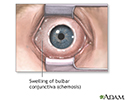Chemosis
Fluid-filled conjunctiva; Swollen eye or conjunctiva
Chemosis is swelling of the tissue that lines the eyelids and surface of the eye (conjunctiva).
Considerations
Chemosis is a sign of eye irritation. The outer surface of the eye (conjunctiva) may look like a big blister. It can also look like it has fluid in it. When severe, the tissue swells so much that you can't close your eyes properly.
Chemosis is often related to allergies or an eye infection. Chemosis can also be a complication of eye surgery, or it may occur from rubbing the eye too much.
Causes
Causes may include:
-
Angioedema
Angioedema
Angioedema is swelling that is similar to hives, but the swelling is under the skin instead of on the surface. Hives are often called welts. They a...
Read Article Now Book Mark Article - Allergic reaction
-
Bacterial infection (
conjunctivitis
)
Conjunctivitis
The conjunctiva is a clear layer of tissue lining the eyelids and covering the white of the eye. Conjunctivitis occurs when the conjunctiva becomes...
 ImageRead Article Now Book Mark Article
ImageRead Article Now Book Mark Article - Viral infection (conjunctivitis)
Home Care
Over-the-counter antihistamines and cool compresses placed on the eyes may help with symptoms due to allergies.
When to Contact a Medical Professional
Call your health care provider if:
- Your symptoms do not go away.
- You have other symptoms, such as eye pain, change in vision, difficulty breathing, or fainting.
What to Expect at Your Office Visit
The provider will perform a physical exam and ask questions about your symptoms, which may include:
- When did it start?
- How long does the swelling last?
- How bad is the swelling?
- How much is the eye swollen?
- What, if anything, makes it better or worse?
- What other symptoms do you have? (For example, breathing problems)
Your provider may prescribe eye medicine to reduce swelling and treat any conditions that may be causing the chemosis.
References
Chapin MJ, Wun PJ, Abelson MB. Mediators of ocular inflammation. In: Tasman W, Jaeger EA, eds. Duane's Foundations of Clinical Ophthalmology . 2013 ed. Philadelphia, PA: Lippincott Williams & Wilkins; 2013:vol. 2, chap 27.
Karesh JW, On AV, Hirschbein MJ. Noninfectious orbital inflammatory disease. In: Tansman W, Jaeger EA, eds. Duane's Clinical Ophthalmology . 2013 ed. Philadelphia, PA: Lippincott Williams & Wilkins; 2013:vol. 2, chap 35.
Rubenstein JB, Tannan A.. Conjunctivitis. In: Yanoff M, Duker JS, eds. Ophthalmology . 4rd ed. St. Louis, MO: Elsevier Mosby; 2014:chap 4.6.
Rubenstein JB, Tannan A. Allergic conjunctivitis. In: Yanoff M, Duker JS, eds. Ophthalmology . 4rd ed. St. Louis, MO: Elsevier Mosby; 2014:chap 4.7.
-
Chemosis - illustration
Chemosis is swelling of the eye surface membranes because of accumulation of fluid. This symptom is often related to an allergic response. Over-the-counter antihistamines, and a cool cloth placed over the eyes, are usually used to try to alleviate the symptoms.
Chemosis
illustration
-
Chemosis - illustration
Chemosis is swelling of the eye surface membranes because of accumulation of fluid. This symptom is often related to an allergic response. Over-the-counter antihistamines, and a cool cloth placed over the eyes, are usually used to try to alleviate the symptoms.
Chemosis
illustration
Review Date: 5/11/2015
Reviewed By: Franklin W. Lusby, MD, ophthalmologist, Lusby Vision Institute, La Jolla, CA. Also reviewed by David Zieve, MD, MHA, Isla Ogilvie, PhD, and the A.D.A.M. Editorial team.

